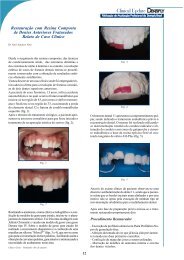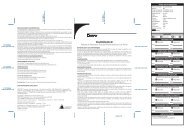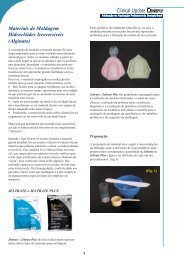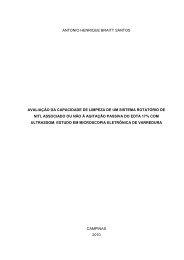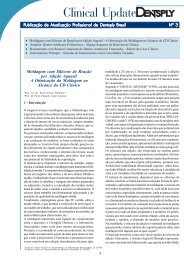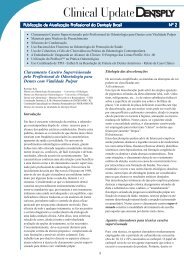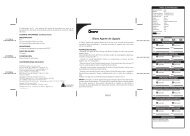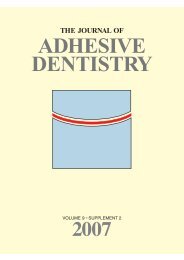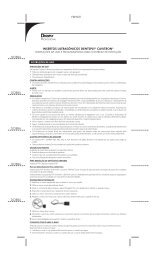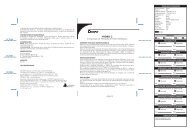Influence of the ProTaper Gutta-Percha Master Point ... - Dentsply
Influence of the ProTaper Gutta-Percha Master Point ... - Dentsply
Influence of the ProTaper Gutta-Percha Master Point ... - Dentsply
- No tags were found...
Create successful ePaper yourself
Turn your PDF publications into a flip-book with our unique Google optimized e-Paper software.
G It Endo - vol. 22 - n. 1, pp. 13-16Gennaio-Marzo 2008ARTICOLO DI RICERCARESEARCH ARTICLECarlos Menezes AguiarMichelle Corrêa de Araújo CoêlhoLuciana Sette Santos ClímacoAndréa Cruz CâmaraFederal University <strong>of</strong> Pernambuco,Recife, BrazilFaculty <strong>of</strong> DentistryDepartment <strong>of</strong> Pros<strong>the</strong>tics and Oral andFacial SurgeryAim: evaluate <strong>the</strong> influence <strong>of</strong> <strong>ProTaper</strong>gutta-percha master point diameterto seal root canals prepared using<strong>the</strong> <strong>ProTaper</strong> rotary system.Methodology: forty mesiobuccal rootsfrom maxillary first molars were randomlydivided into four experimentalgroups containing 10 teeth. The group1 was instrumented with <strong>ProTaper</strong> rotaryfiles F1 and was obturated using a<strong>ProTaper</strong> gutta-percha master pointF1 and AH Plus sealer; group 2 was instrumentedwith F2 and was obturatedusing a <strong>ProTaper</strong> gutta-percha masterpoint F2 and AH Plus sealer; group 3was <strong>the</strong> positive control group and <strong>the</strong>group 4 was <strong>the</strong> negative control group.The apical leakage was evaluated by dyepenetration. Each specimen was suspendedvertically in a clamp stretchedover a reservoir container filled with Indiaink and stored in 100% humidity at37±1ºC for seven days. The sampleswere removed from <strong>the</strong> dye and <strong>the</strong>roots were sectioned longitudinally ina bucco-lingual direction. The maximumlinear dye penetration was measuredby two independent evaluators usinga stereoscopic magnifier with 10Xmagnification and a ruler with a 1.0mm graduation.Results: Kruskal-Wallis test revealedthat <strong>the</strong> differences between <strong>the</strong> experimentalgroups were not statistically significant.A level <strong>of</strong> significance <strong>of</strong> 0.05was adopted.Conclusions: <strong>the</strong> group 2 showed <strong>the</strong>least dye penetration.Key words:Epoxy resins, <strong>Gutta</strong>-percha, infiltration,sealants.Rotary instruments made from nickeltitaniumalloy are <strong>the</strong> result <strong>of</strong> recentadvances in endodontics (1) and <strong>the</strong>ypermit a very high degree <strong>of</strong> automationin <strong>the</strong> biomechanical preparation<strong>of</strong> root canals (2). Those with a triangularsection cut <strong>the</strong> dentine more efficientlyand are thus able to producemore deviations in <strong>the</strong> trajectory <strong>of</strong> <strong>the</strong>root canal (3).Root canal sealing has played an importantrole in dental <strong>the</strong>rapy and <strong>the</strong>biomechanical preparation by itself isnot capable <strong>of</strong> disinfecting root canals(4). A complete and hermetically sealedroot canal is very important for achievingsuccess in endodontic <strong>the</strong>rapy (5).Although, <strong>the</strong>re are a large number <strong>of</strong>filling materials and obturation techniques,<strong>the</strong> combination <strong>of</strong> gutta-perchaand a sealer is <strong>the</strong> most widely usedin clinical practice (6).The aim <strong>of</strong> <strong>the</strong> present study was <strong>the</strong>reforeto evaluate, in vitro, <strong>the</strong> influence <strong>of</strong>Corrispondenza:Pr<strong>of</strong>. Carlos Menezes AguiarRua Heitor Maia Filho, 52 Apt. 201Madalena, Recife PE 50750-525 BrasilTelefone: (+55) 81 3467 6821E-mail: cmaguiar@ufpe.br<strong>Influence</strong> <strong>of</strong> <strong>the</strong> <strong>ProTaper</strong> <strong>Gutta</strong>-percha master pointdiameter in <strong>the</strong> apical sealingABSTRACTINTRODUCTION<strong>ProTaper</strong> gutta-percha master point diameterto seal root canals prepared using<strong>the</strong> <strong>ProTaper</strong> rotary system.MATERIALSAND METHODSForty mesiobuccal roots with matureapices from extracted human maxillaryfirst molars obtained from <strong>the</strong> ToothBank <strong>of</strong> <strong>the</strong> Departament <strong>of</strong> Pros<strong>the</strong>ticsand Oral and Facial Surgery <strong>of</strong> FederalUniversity <strong>of</strong> Pernambuco (UFPE) wereused in this study. These molars had acurvature angle ranging from 30 to 46degrees (7). Previous approval for thisstudy was obtained from <strong>the</strong> Ethics inResearch Committee <strong>of</strong> <strong>the</strong> Center <strong>of</strong>Health Science <strong>of</strong> <strong>the</strong> UFPE (080/2005- CEP/ CCS). The teeth were stored in1% sodium chlorite until needed. Allroots were radiographed mesio-distallyto ensure <strong>the</strong> presence <strong>of</strong> a single rootcanal. Coronal access was achieved usinga diamond #1016 bur (KG So rensen,São Paulo, Brazil), followed by straightlineaccess to <strong>the</strong> mesial wall with anEndo-Z bur (Maillefer, Ballaigues, Swit -zerland) in a high-speed handpiece underwater refrigeration. After confirming<strong>the</strong> presence <strong>of</strong> a single root canal, a #08K-File (Maillefer, Ballaigues, Switzerland)was introduced into <strong>the</strong> mesio -buccal canal for <strong>the</strong> purpose <strong>of</strong> detecting<strong>the</strong> presence <strong>of</strong> obstructions and/or© CIC EDIZIONI INTERNAZIONALI© Copyright 2008, CIC Edizioni Internazionali, Roma.13
<strong>Influence</strong> <strong>of</strong> <strong>the</strong> <strong>ProTaper</strong> <strong>Gutta</strong>-<strong>Percha</strong> <strong>Master</strong> <strong>Point</strong> Diameter in <strong>the</strong> Apical SealingFig. 1 - Root canal filling with F2 gutta-percha point and AH Plus sealershowing infiltration (blue).Otturazione canalare (eseguita con cono di guttaperca F2 e sealer AH Plus)in cui si evidenzia infiltrazione di colorante (blu).Fig. 2 - Root canal filling with F2 gutta-percha point and AH Plus sealer notshowing infiltration.Otturazione canalare eseguita con cono di guttaperca F2 e sealer AH Plusin cui non si evidenzia infiltrazione di colorante.Taper gutta-percha points had a bettereffect.Yücel & Çiftçi (11) compared <strong>the</strong> bacterialpenetration (Enterococcus faecalis)following obturation with System B,Lateral Compaction, Thermafil, Single<strong>ProTaper</strong> <strong>Gutta</strong>-<strong>Percha</strong> and LaterallyCompacted <strong>ProTaper</strong> <strong>Gutta</strong>-<strong>Percha</strong>with AH Plus sealer. The evaluationwas carried out for 60 days. At 30 dayFig. 3 - Root canal filling with F1 gutta-percha point and AH Plus sealer notshowing infiltration.Otturazione canalare eseguita con cono di guttaperca F1 e sealer AH Plusin cui non si evidenzia infiltrazione di colorante.Fig. 4 - Root canal filling with F1 gutta-percha point and AH Plus sealer showinginfiltration (blue).Otturazione canalare eseguita con cono di guttaperca F2 e sealer AH Plusin cui si evidenzia infiltrazione di colorante (blu).<strong>the</strong> slowest penetration was observed in<strong>the</strong> groups <strong>of</strong> System B and LaterallyCompacted <strong>ProTaper</strong> <strong>Gutta</strong>-<strong>Percha</strong>.The fastest penetration was observed in<strong>the</strong> groups <strong>of</strong> Thermafil and Single Pro-Taper <strong>Gutta</strong>-<strong>Percha</strong>. At 60 day <strong>the</strong>rewas no statistically significance differenceamong all groups.The NiTi rotary instruments have advantagessuch as ease at use and efficiencycompared with hand preparation,fewer instrumentation errors anda better preparation <strong>of</strong> curved canals(1). However, <strong>the</strong> rotary instrumentswith a triangular cross-section, such asthose used in <strong>the</strong> <strong>ProTaper</strong> rotary system,have greater cutting efficiencyand, as a result, with this a greater risk<strong>of</strong> morphological alterations in <strong>the</strong> rootcanal (3).© CIC EDIZIONI INTERNAZIONALI15
Carlos Menezes Aguiar e Coll.BIBLIOGRAFIAThe great taper master gutta-perchapoint allows a better apical seal in canalsprepared with rotary systems (12),which is in agreement with Al-Hadlaq;Al-Rabiah (2) and with <strong>the</strong> results <strong>of</strong> thisstudy. In addition to <strong>the</strong> angle <strong>of</strong> taper,<strong>the</strong> results <strong>of</strong> this study indicate that <strong>the</strong>prepared diameter was an importantfactor in <strong>the</strong> apical seal. The specimenswhere <strong>the</strong> canals were filled with mastergutta-percha point <strong>ProTaper</strong> F2produced better results than F1.On <strong>the</strong> basis <strong>of</strong> <strong>the</strong> results <strong>of</strong> <strong>the</strong> presentresearch, <strong>the</strong> use <strong>of</strong> <strong>the</strong> <strong>ProTaper</strong>gutta-percha point in filling <strong>the</strong> rootcanal system may be strongly recommendedsince it permits a larger andmore uniform gutta-percha. In thisstudy <strong>the</strong> worst result was from <strong>the</strong> F1<strong>ProTaper</strong> point, in relation to <strong>the</strong> dyeleakage, which could be explained as beingdue to <strong>the</strong> transverse thickness <strong>of</strong><strong>the</strong> gutta-percha points and <strong>the</strong> needfor a thicker sealer layer. The use <strong>of</strong> achelate solution facilitates <strong>the</strong> removal<strong>of</strong> <strong>the</strong> smear layer, which, in its turn, facilitates<strong>the</strong> penetration <strong>of</strong> <strong>the</strong> sealer into<strong>the</strong> base <strong>of</strong> <strong>the</strong> epoxy resin in <strong>the</strong>dentine canals, producing a better adhesion<strong>of</strong> <strong>the</strong> sealer to <strong>the</strong> dentine bymeans <strong>of</strong> a mechanical aggregation (13).AH Plus is an epoxyamine-based resin1. Schäfer E. Root canal instruments formanual use: a review. Endod Dent Traumatol1997;13: 51-64.2. Al-Hadlaq SM, Al-Rabiah AA. In vitro evaluation<strong>of</strong> three techniques to obturate 0.06taper canal preparations. Aust Endod J2005;31:1-3.3. Peters OA, Peters CI, Schönenberger K,Barbakow F. <strong>ProTaper</strong> rotary root canalpreparation: effects <strong>of</strong> canal anatomy on finalshape analyzed by micro CT. Int EndodJ 2003;36:86-92.4. Wu MK, Van Der Sluis LWM, Ardila CN,Wesselink PR. Fluid movement along <strong>the</strong>coronal two-thirds <strong>of</strong> root fillings placed bythree different gutta-percha techniques. InterEndod J 2003; 36: 533-40.5. Brosco VH, Bernardinelli N, Moraes IG.“In vitro“ evaluation <strong>of</strong> <strong>the</strong> apical sealing<strong>of</strong> root canals obturated with different techniques.J Appl Oral Sci 2003; 11: 181-5.6. Wu MK, Groot SD, Van Der Sluis LWM,Wesselink PR. The effect <strong>of</strong> using an invertedmaster cone in a lateral compactiontechnique on <strong>the</strong> density <strong>of</strong> <strong>the</strong> gutta-perchafill. Oral Surg Oral Med Oral Pathol OralRadiol Endod 2003; 96: 345-50.7. Günday M, Sazak H, Garip Y. A comparativestudy <strong>of</strong> three different root canalcurvature measurement techniques andmeasuring <strong>the</strong> canal access angle in curvedcanals. J Endod 2005; 31: 796-8.8. Öztan MD, Özgey E, Zaimoglu L, Erk, N.The effect <strong>of</strong> various root canals sealers onIndia ink and different concentrations <strong>of</strong>methylene blue. J Oral Science 2001; 43:245-8.9. Villegas JC, Yoshioka T, Kobayashi C, SudaH. Quality <strong>of</strong> gutta-percha root canal fillingsusing differently tapered gutta-perchamaster points. J Endod 2005; 31: 111-3.10. Orucoglu H, Sengun A, Yilmaz N. Apicalleakage <strong>of</strong> resin based root canal sealerswith a new computerized fluid filtrationmeter. J Endod 2005; 31: 886-90.11. Yücel AÇ, Çiftçi A. Effects <strong>of</strong> differentroot canal obturation techniques on bacterialpenetration. Oral Surg Oral Med OralPathol Oral Radiol Endod 2006; 102: 88-92.12. Bal AS, Hicks ML, Barnett F. Compari-and was chosen in this case as <strong>the</strong> rootendfilling material for its favorableproperties, such as an excellent sealingcapacity, lower leakage, bond strength,good radiopacity and bonding (14-17).Based on <strong>the</strong> results <strong>of</strong> <strong>the</strong> present experiment,it could be concluded that <strong>the</strong>group obturated with <strong>ProTaper</strong> guttaperchamaster point F2 showed <strong>the</strong> leastdye penetration. However, <strong>the</strong> differencewas not statistically significant.Acknowledgements:Our thanks to CNPq for <strong>the</strong> financialhelp enabling us to carry out thisstudy.son <strong>of</strong> laterally condensed .06 and .02 taperedgutta-percha and sealer in vitro. J Endod2001; 27: 786-8.13. Sousa-Neto MD, Passarinho-Neto JG,Carvalho-Júnior JR, Cruz-Filho AM, PécoraJD, Saquy PC. Evaluation <strong>of</strong> EDTA, EGTAand CDTA on dentin adhesiveness and microleakagewith different root canal sealers.Braz Dent J 2002; 13: 123-8.14. De Almeida WA, Leonardo MR, TanomaruFilho M, Silva LA. Evaluation <strong>of</strong> apicalsealing <strong>of</strong> three endodontic sealers. IntEndod J 2004; 33: 25-7.15. Çobankara FK, Adanir N, Belli S, PashleyDH. A qualitative evaluation <strong>of</strong> apicalleakage <strong>of</strong> four root-canal sealers. Int EndodJ 2002; 35: 979-84.16. Kardon BP, Kuttler S, Hardigan P, DornSO. An in vitro evaluation <strong>of</strong> <strong>the</strong> sealingability <strong>of</strong> a new root-canal-obturation system.J Endod 2003;29: 658-61.17. Siqueira Júnior JF, Roças IN, Abad EC,Castro AJR, Gahyva, SM, Faviere A. Ability<strong>of</strong> three root-end filling materials to preventbacterial leakage. J Endod 2001;27: 673-5.© CIC EDIZIONI INTERNAZIONALI16




